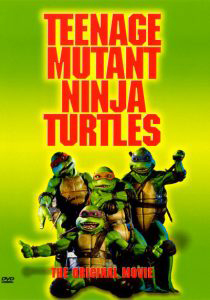When people ask me my favorite superhero movie, I always say “Teenage Mutant Ninja Turtles” (which will mark its 24th anniversary on Sunday) and it’s always treated as an odd selection – even though pretty much everyone my age loved the movie as a kid.
It’s not as dark as the Tim Burton “Batman” or Christopher Nolan “Dark Knight” films, and not as slick and polished as most 21st century superhero flicks such as the “X-Men” saga.
But it has a certain grittiness and realness just the same, thanks to John Du Perez’s score (one of many great film scores sadly lacking a commercial release, although “Shredder’s Suite” is at least on the soundtrack); cutting-edge Turtle and Splinter costumes from Jim Henson Studios; its faithfulness to central plot and character elements from the Mirage comics; and the New York and Wilmington, N.C., locations.

“Teenage Mutant Ninja Turtles” (1990)
Director: Steve Barron
Writers: Bobby Herbeck (story, screenplay), Todd W. Langen (screenplay)
Stars: Judith Hoag, Elias Koteas, Corey Feldman
Even Roger Ebert, who generally was unimpressed by the movie, complimented the sets as having a flavor similar to the previous year’s “Batman”; so if nothing else, “TMNT” looks really good.
Drawing from the Mirage classics
I think Bobby Herbeck and Todd W. Langen’s script works because it doesn’t try to out-think Eastman and Laird’s stories. Sure, it tightens the story up to fit in a standard three-act, 90-minute structure, but it’s easy to find the elements lifted from the comics:
Issue 1: The rooftop battle. It’s more stagey and comical in the movie – note how the Shredder just stands back and politely waits as the Turtles huddle up — and Splinter is also involved this time. That makes sense for movie purposes, and indeed, I’ve always found it a bit odd that Splinter doesn’t confront Shredder in person in the comics.
Issue 2: The Turtles meet April. She’s hilariously accepting of the existence of giant, talking turtles and a rat in the comic. In the movie, it’s played for over-the-top humor, with Judith Hoag’s April thinking she’s having a nightmare and wondering “Why don’t I ever dream of Harrison Ford?” In both cases, she quickly becomes part of the gang’s surrogate family.
Issue 3: The Turtles’ lair is ransacked and Splinter is kidnapped. In the movie, it’s the Foot Clan doing the vandalism and the kidnapping. In the comic, it’s the mousers doing the ransacking and the (altruistic, as it turns out) TCRI aliens who nab Splinter. Humorously, Issue 45 of the comics forgets this continuity discrepancy and makes reference to the Foot Clan, rather than the mousers, driving the Turtles from their lair.
“Raphael” one-shot: Raph meets Casey and they fight and argue about the nuances of vigilante crimefighting. They both believe in vigilantism, but Casey goes further with his violence. The scenes are almost identical in each version.

“Leonardo” one-shot and Issue 10: The fight at the apartment and antique shop. In the comics, Leo is gravely injured; in the movie, Raph is. The movie features Tatsu as the Foot leader, opting to save Shredder for the final-act confrontation.
The comic has Shredder as the leader, as this is the story with the shocking revelation that he is still alive. In both cases, Casey turns the tide of the battle, they escape through a secret door, and they flee to the farmhouse (belonging to April’s family in the movie, Casey’s in the comics). The movie never mentions that the farm is in rural Northampton, Mass., but there’s no reason it can’t be.
Issue 11: Recovering at the farm. Casey fixes the truck with Raph in the comic, but with Don in the movie. Splinter is at the farm in the comic, but not in the movie, and Splinter’s absence is essential to giving this section of the film a slight dash of the comics’ serious, melancholy feel that was otherwise undercut by the jokiness.
Even smaller moments seem to come from the comics. The pre-credits sequence where the gang trusses up the bad guys in a neat package for the cops might’ve come from the short story “Night Life,” and the ability of Splinter to spirit-walk and talk to his sons might’ve come from Issue 9.
Kinda like ‘Moonlighting’
The movie beats the comic to the punch on a couple of counts, notably the April-Casey relationship. It totally works in the film because Hoag and Elias Koteas have great chemistry (it really is “kinda like ‘Moonlighting,’ ” as Don observes), but the comics’ approach is more complex and they don’t really get together until the end of “City at War” in 1993.
Also, while the comic is vague about what exactly the Foot Clan does (other than being bad guys), the movie Foot Clan is vibrantly shown to be a thriving thievery enterprise attracting wayward youths who skateboard and shoot pool in an old warehouse while blasting M.C. Hammer and Ya Kid K (Fun piece of trivia: Ya Kid K is a chick, not a dude. Look it up if you don’t believe me).
The Foot Clan’s acceptance of pretty much anyone is also – inevitably — its downfall, so in a way the comic’s lack of explanation makes its version of the Foot Clan more threatening.
The movie gets the Leo-Raph relationship right, although it’s softened a bit for the sake of a resolution – they hug and Raph says “Leo, don’t,” implying that their brotherly love goes beyond words. Most impressive – and humorous – is the scene where Don and Mike say: “Fight?” “Fight.” “Kitchen?” “Kitchen.”
Josh Pais – the only Turtle actor to perform both in the suit and with his voice — nails Raph’s Brooklyn accent. I’d rank his performance even a notch above Corey Feldman’s Donatello, although for sheer comic-to-movie perfection, the winner is Koteas as Casey Jones.
Casey the (not quite) hero
Casey is a great not-quite-hero: He ostensibly learns a lesson about gratuitous violence (from Raph of all people!), but doesn’t really (he gleefully beats up “leftovers” and crushes the hapless Shredder in the garbage truck).
He gets the chick in the end without having to change who he is one iota; April just grows to love him for who he is (thus making “TMNT” a rare film that fulfills a universal male fantasy; in this medium, the flawed male usually changes in order to attract the woman).
He finds kinship with the Turtles and Splinter, and on some unspoken level it’s their shared love of violence that binds them, yet they can sell themselves as having family values. And it’s all legitimate (on the surface), because they truly are the good guys of the narrative every step of the way.
But for all the lifts from the comic plot and the anti-conventionalism of Casey’s arc, “TMNT” is also a kids’ film, and this is hugely apparent to me when I watch the movie on the cusp of a Mirage Comics binge-reading session. Nonetheless, I still smile at all the quips and goofy moments.
Because we all fell in love with this movie as kids, our favorite moments tend to be things the filmmakers probably didn’t anticipate: “A Jose Canseco bat – tell me, you didn’t pay money for this.” … “Pork rind?” “Pork rind.” … “Regular, or menthol?”
April the reporter
April-as-reporter is the main element borrowed from the heavily kid-targeted 1987 cartoon (another is the Turtles’ love of pizza, which is not at all central to the Mirage comics; in fact, in one Michael Dooney “Turtle Soup” yarn, the Turtles profess to be sick of pizza).
The switch from Channel 6 to Channel 3 is a nod to Wilmington’s Channel 3, where some scenes were shot. She wears a yellow rain slicker in the parking-lot mugging sequence, no doubt a nod to Toon April’s yellow jumpsuit. (Does anyone wear a jumpsuit in the real world? I suspect it’s purely a fiction thing.)
Hoag’s April is not at all like her timid Mirage Comics counterpart, aside from sharing a questionable frizzy hairstyle. Movie April has endless reserves of confidence; in fact, she’s central to taking down the Foot Clan with her reporting at Channel 3.
This is not a criticism of the actress by any means, as this confident characterization is in the script, and no doubt in Steve Barron’s direction, too. If I’m being completely honest, I have to say I like Movie April better than Comic April, even though Comic April is the “official April” to me.
April being a reporter leads to three characters exclusive to the movie: Her boss, Charles Pennington; his son, Danny; and Police Chief Sterns. (Without a doubt, it was the right choice to nix Burne, Vernon and Irma.) These new characters are all crucial – especially Danny, the link between the Foot and the Turtles – but I tend to underrate them because they are not in the comics, the cartoon, or even the movie sequels.
I also always forget that Ernie Reyes Jr. – Keno in “TMNT II” – does stunts for Donatello in the first movie. Most fans are probably familiar with this bit of trivia, though: All the costumed regulars have out-of-costume cameos, notably Michelan Sisti (Michaelangelo) as the Domino’s Pizza delivery guy.
The right balance
From the perspective of filmmakers who want to please both the comic fans and kids, “TMNT” hits the sweet spot. Future movie entries drastically lean toward the kiddie elements, so much so that the home-video boxes for “TMNT II” and “TMNT III” are labeled “comedy,” whereas the first film is labeled “action.” But the 1990 movie gets the balance right.
Every cheesy line – “We were awesome!” … “God, I love being a Turtle!” … “Cowabunga!” – makes me smile (OK, most of them), and even when that stuff gets old, it’s balanced out by genuine moments. Highlights are the Turtles showing up at April’s door looking sad (“Splin-ter,” Leo says simply), Raph waking up and Leo hugging him, and Casey introducing himself to Splinter as “a friend.”
Herbeck and Langdon’s best adult-comedy writing comes when Casey thinks “claustrophobic” means “homosexual.” The April-Casey scenes on the farm also hold up beautifully, particularly when an angrily apple-munching Casey falls on his butt when the porch swing breaks. (Koteas attacks that apple the same way Rick Veitch shows Casey devouring a burger in Issue 30).
While I can’t deny that the film achieves a nice balance in appealing to both kids and adults, I can’t help but wonder how cool it would be if it were completely faithful to the comics’ tone. I found this intriguing quote in the book “Wilm on Film” from “TMNT” puppeteer David Rudman:
“(The film was) supposed to be a darker cult kind of movie for older kids. After it was shot and edited, they actually went back and tried to tone it down a little bit.”
Although 11-year-old me thought “TMNT” was the pinnacle of film perfection (with only the “Star Wars” trilogy in the same class), adult me drools over the idea of a TMNT movie in the style of the Mirage comics.
Softening the violence
I mentioned that the quips and jokes always pop out as contrasts to the source material, and another element of departure is the violence. In the comic, just to cite one example, the Turtles aggressively draw out and kill Shredder in Issue 1.
In the film, you see very few instances of a living being getting struck with a fist or ninja weapon. This is clearly established in the opening parking-lot scene when the muggers yell “Get her purse!” and “I got her watch!” rather than something like “Kill her!” or even “Don’t let her get away!”
Then the Turtles’ beat-down of the baddies happens in the dark, entirely through sound effects. There’s no blood in the movie. Even when Mike is looking at Don’s injured leg in the farmhouse, his leg looks totally normal.
Don’t get me wrong, the violence is implied throughout, and – let’s be honest — the good guys win by being better at violence than the bad guys. (Yeah, Casey gives a nice little speech about family that shames Sam Rockwell and other the Foot initiates, but I gotta think the fact that he knocked out Tatsu with a golf club helps sell his case.)
But it’s notable how the writing, editing and sometimes even the music (the gorgeously moody “Shredder’s Suite” notwithstanding) conspire to undercut every instance of danger or violence. In the antique store fight, Casey says he’ll cover the retreat, and Leo says “Good idea!” April knocks out a Foot soldier with a bo, and Mike says, “You’re a natural, sis!” As the movie escalates toward its conclusion with more Turtles vs. Foot fighting, the music actually becomes playful.
And then there’s “Woooops!” — Casey literally crushes a man to death with a garbage compactor (on purpose, and with glee), but as kids, we all just loved the way Koteas delivered the line. Despite most of the violence being softened through its presentation, parental watchdog groups still criticized the movie, leading to the sequels de-emphasizing violence even further — Mike uses sausage links rather than nunchucks at the start of “TMNT II.”
Gateway to comics fandom
On the other hand, it’s ridiculous for me to criticize “TMNT” for not being true to the spirit of the comics and instead compromising to get the cartoony, toy-shilling elements in there. (Although, oddly, there were no movie-specific toys in 1990. At that time, the toys were all tied to the cartoon.
Not that that was much of a problem since both film and TV show were aimed at the same audience; in my case, the movie led me to the cartoon, and the cartoon led me to the toys.)
After all, Burton’s “Batman” took the “dark,” “adult” approach just one year prior, and I did not latch onto that movie (although many of my classmates loved it). I saw that and the insanely dark “Batman Returns” at some point in the 1990s, but neither came close to hooking me the way “TMNT” did.
Indeed, the juvenile elements of the 1990 film are probably what made me like “TMNT” – further evidence of this theory is the fact that I also liked the vastly inferior “TMNT II” and even made excuses for the god-awful “TMNT III” upon its initial release.
And once I liked “TMNT,” I started on the path that eventually led me to the Eastman & Laird comics, and to writing about those comics on my blog to mark the 30th anniversary of the franchise. All criticisms and caveats aside, though, when someone asks me my favorite superhero movie, I still say “Teenage Mutant Ninja Turtles,” and I still mean it.

